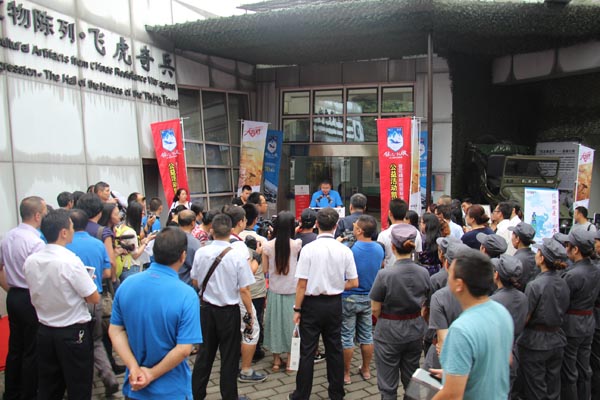 |
|
A ceremony is held to welcome the return of the search team. [Photo by Huang Zhiling/www.chinadaily.com.cn] |
The remains of an American transport plane that crashed in the Ruoguo Glacier in Nyingchi, Tibet during the winter of 1943 have been welcomed to the Jianchuan Museum Cluster in Anren town, Dayi county, Sichuan province.
The plane, with the serial number 41-24688, went down while flying over the Hump, the name for the eastern end of the Himalayan Mountains. Wreckage was recovered by a search team put together by the museum.
Between 1942 and 1945, weapons and other cargo were transported from India to Yunnan province using the arduous Myanmar roads and the Hump air route over the Himalayas as China's land and water routes were cut off by the Japanese.
Hump pilots transported about 850,000 tons of materials but about 1,500 American planes crashed in Southwest China.
In September 1993, Luo Song, a local hunter found the plane and the bodies of five American pilots in the glacier 4,100 meters above sea level. Although the bodies were handed over to America, most parts of the plane were left there.
Six years ago, Fan Jianchuan, curator of the Jianchuan Museum Cluster, learned from a fellow ex-serviceman that the plane was in no-man’s land in Tibet.
"I told myself I would bring it to my museum," he said. Organized by his museum and other institutions including the Xinhua News Agency, a motorcade of people set out for Tibet on August 5.
"Together with nearly 60 searchers they brought back some 50 remains of the plane to my museum on Friday," Fan said.
Tsering, the Tibetan chief of the security department of the museum, participated in the search. He said searchers found a pair of tall boots, two pairs of high military boots and one pair of low military boots.
"The boots were the same as those I found in 1993," said Luo who was the guide for the searchers.
Because of difficulty in transportation, searchers took away only some 50 items. "It was very difficult to reach the glacier as there was no path or bridge. Searchers had to make paths and bridges themselves," said Yang Jianchao, deputy curator of the museum who was in charge of the search.
It was the first time that such a large number of plane remains had been transported to a museum, he said.
"All my hardship was worthwhile when I found the plane," said Hu Zhiyang, a member of the search team.
Jiang Fan, another team member, said he felt as if he had seen the American pilots alive when he saw the remains of the plane.
"I was moved by the excellent young people who sacrificed their lives on foreign soil for the sake of world peace," he said.
According to Liu Ronghua, chief of the general office of the Jianchuan Museum Cluster, the remains will shared by his museum, the Museum of the War of Chinese People's Resistance against Japanese Aggression in Beijing and museums in the United States, France and Germany.
